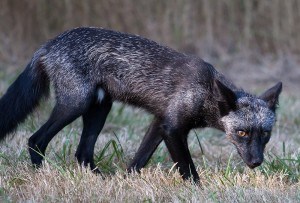
One of my favourite things about writing this column is that the people who read it sometimes send me amazing or interesting pictures, and ask me to help figure out what the heck we are looking at. I can’t tell you how much I love this. When you work alone in your home office all day, it’s good to know other creature-lovers are out there crouched over a weird bug or plant with their camera.
I thought it might be nice to share some of these queries with you once in a while, in the hopes that others have had the same questions. Two species have come up recently: The first is the snowberry clearwing, and the second is the red fox…when it’s not so red. We’ll start with the little guy, and work our way up.
Snowberry Clearwing
(AKA Hummingbird Moth)
It hovers like a hummingbird. It has a moth body, but see-through wings. As you creep closer to this alien being, it unrolls its crazy long, black tongue and pokes somewhat clumsily at a flower. None of it makes sense–it’s a Franken-bug. For cripes sake, WHAT IS IT?
It’s a snowberry clearwing – a member of the sphinx-moth family, except without all the sphinx-moth-y-ness. Sphinx moths can be beautifully coloured, yes, and like most

moths they both have antennae that are feathered (not clubbed like butterflies). However, sphinx moths are largely nocturnal, whereas the snowberry clearwing prefers flitting amongst the flowers in the sunshine, unsettling humans wherever they go though they pose us no harm at all. Here’s another big difference: Many sphinx moths do not have mouths as adults. This means they don’t feed. Can you imagine? No wine and cheese? Meanwhile, the snowberry clearwing flies around syphoning sweet nectar with its super-long straw mouth. Every family has a member that doesn’t quite fit in, and with the Sphinx moths, it’s definitely the snowberry clearwing. Maybe that’s why I like them so much.
The Many Phases of the Red Fox
A couple of weeks ago, a neighbour came over with a description of a wild, dog-like animal she couldn’t quite figure out. She’s a long-time local and pretty astute about wildlife. So when she told me about it I began tapping my fingertips together in front of my face and hoping for a coy-wolf.
However, after searching up some photos on the web we realized it was a red fox. Except it wasn’t really red….and here’s what I learned. Red foxes can really mess. you. up.
In fact, calling all red foxes “red” is about as accurate as calling all cows brown. Although general features remain the same, for example a bushy white-tipped tale that is almost half as long as the fox itself, and a build smaller and slighter than a coyote. Coat colours can also vary dynamically across a red fox population.
In Alberta, three main phases or “morphs” are recognized: The red, cross and silver. The most common is thought to be the red morph–the orangey-brown fox we see in children’s books. The next most common is the cross fox, which displays a coat of dark brown/black and orange, with a characteristic dark “cross” across it’s back. Finally, there is the silver morph, it’s name derived from the grey guard hairs that pepper its body. It can range from black to grey, depending on how many guard hairs it has.

None of these morphs have precise guidelines, and variations on all of them exist. Also, depending on the time of year, a fox can look slightly bigger or smaller as it sheds and grows hair depending on the season. So you see how confusing it can be. Of course, to see a fox at all you are incredibly lucky. They are often solitary, incredibly stealthy, and wary of people. You are many times more likely to see a clever coyote darting across the road. My neighbour was lucky to get a good, long look at a cross morph in the daylight hours, and I was lucky she shared the experience with me.
Thanks again to everyone who sends me weird and wonderful questions and photos from the Rockies. If you have something you want to share, you can track me down at my website: nikiwilson.com. I look forward to hearing from you!
Niki Wilson Special to the Fitzhugh
